Thomas Cook's Financial Performance: A Comprehensive Analysis
VerifiedAdded on 2023/01/17
|11
|2402
|80
Report
AI Summary
This report provides a detailed financial analysis of Thomas Cook, examining its performance from 2015 to 2018, and comparing it to TUI Travels. The analysis covers profitability ratios (gross profit, net profit), liquidity ratios (current ratio, quick ratio), solvency ratios (debt-equity ratio, gearing rat...
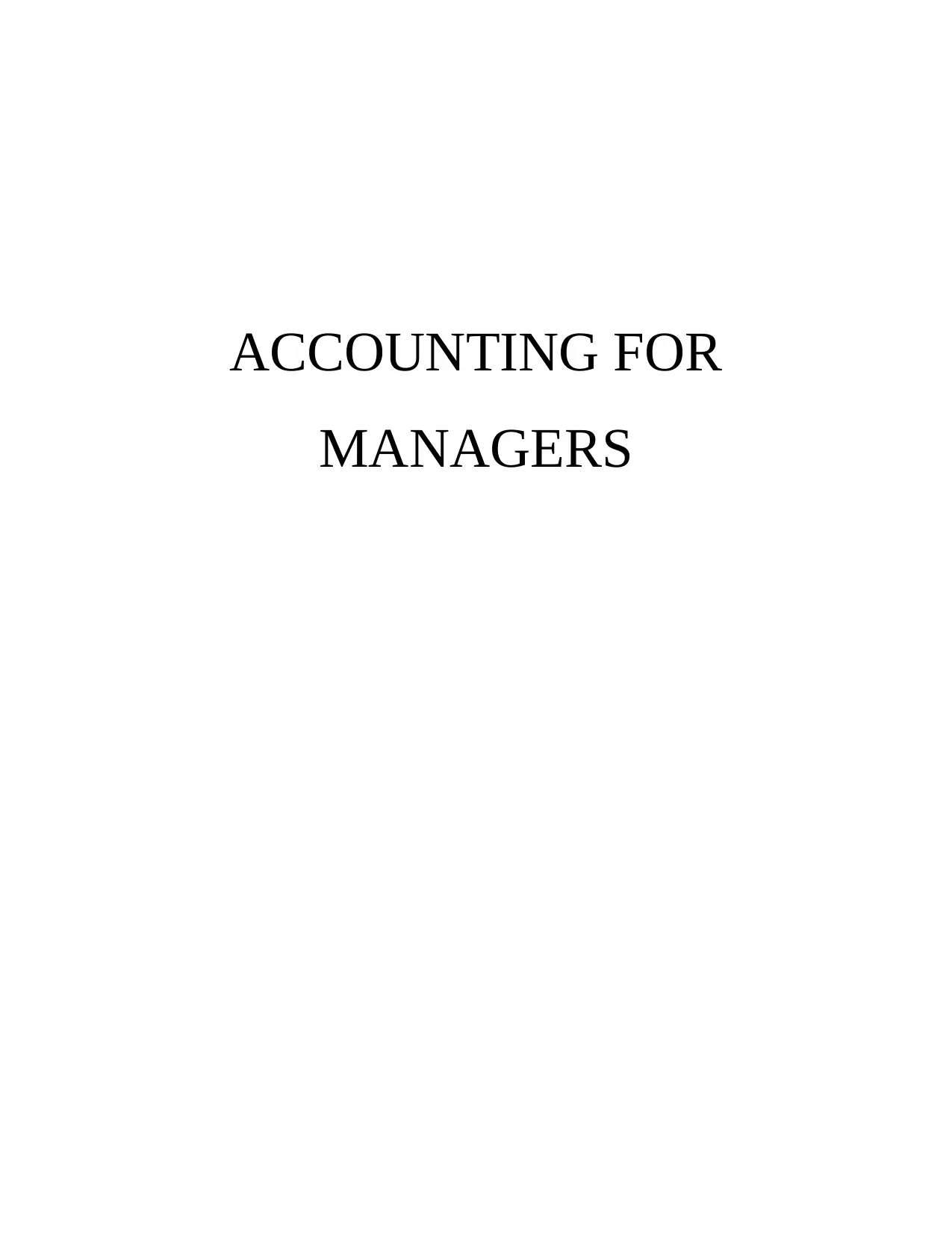
ACCOUNTING FOR
MANAGERS
MANAGERS
Paraphrase This Document
Need a fresh take? Get an instant paraphrase of this document with our AI Paraphraser
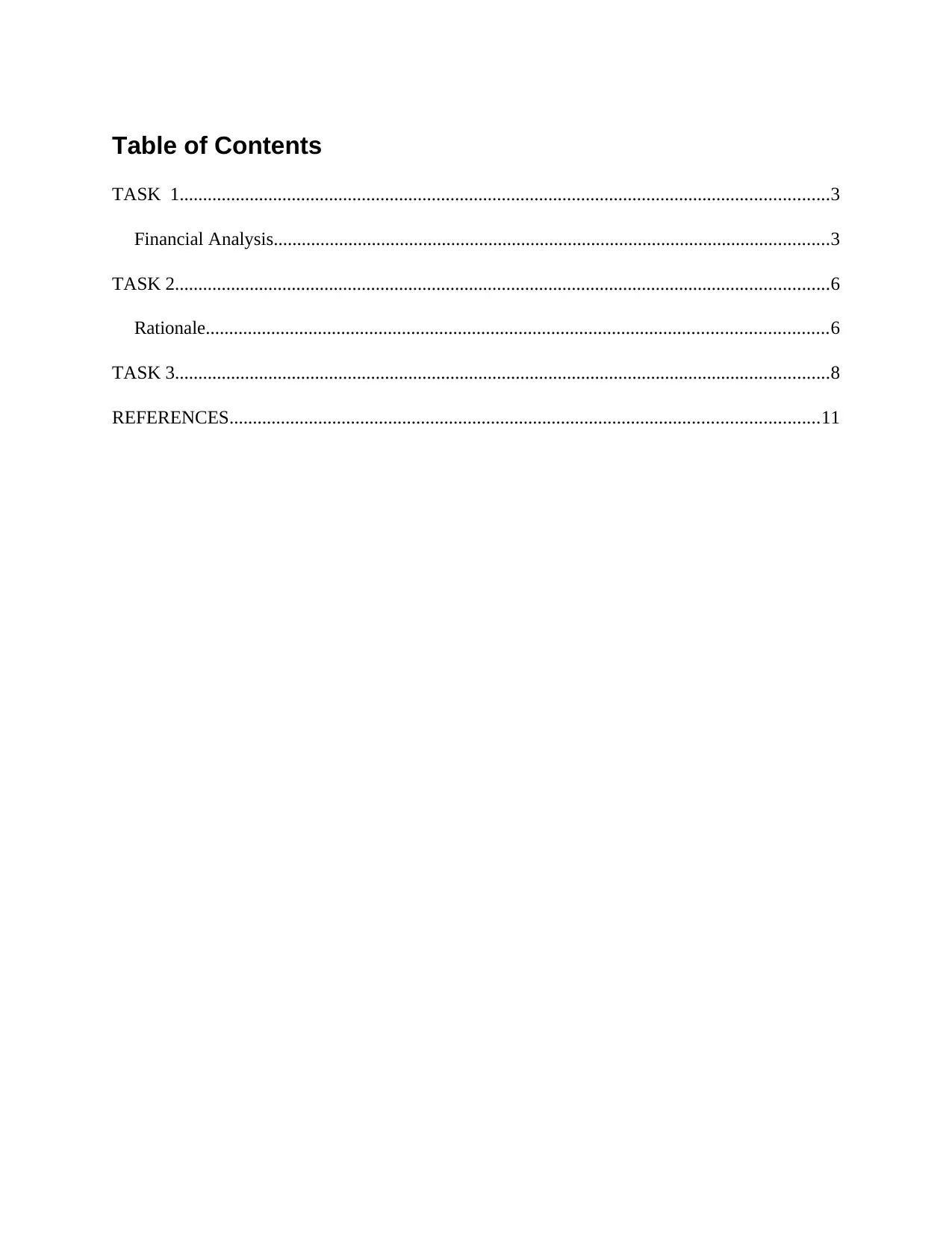
Table of Contents
TASK 1...........................................................................................................................................3
Financial Analysis.......................................................................................................................3
TASK 2............................................................................................................................................6
Rationale.....................................................................................................................................6
TASK 3............................................................................................................................................8
REFERENCES..............................................................................................................................11
TASK 1...........................................................................................................................................3
Financial Analysis.......................................................................................................................3
TASK 2............................................................................................................................................6
Rationale.....................................................................................................................................6
TASK 3............................................................................................................................................8
REFERENCES..............................................................................................................................11

TASK 1
Financial Analysis
Thomas Cook
Profitability ratio
analysis
Particulars Formulas 2015 2016 2017 2018
Gross Profit 1,772 1,822 1,990 1,933
Net profit 19 9 9 -163
Sales revenue 7,834 7,812 9,006 9,584
GP ratio Gross profit / sales * 100 22.62% 23.32% 22.10% 20.17%
NP ratio Net profit / sales * 100 0.24% 0.12% 0.10% -1.70%
Working capital
ratio analysis
Particulars Formulas 2015 2016 2017 2018
Current assets 2,035 2,656 1,576 1,793
Current liabilities 3702 4630 152 356
Inventory 32 43 0 0
Prepaid expenses 0 0
Quick assets 2003 2613 1576 1793
Current ratio Current assets / current liabilities 0.55 0.57 10.4 5.0
Quick ratio Current assets - (stock + prepaid expenses) 0.54 0.56 10.37 5.04
Solvency ratio
analysis
Particulars Formulas 2015 2016 2017 2018
Long-term debt 1038 847 653 659
Shareholder's equity 368 391 2858 2874
Debt-equity ratio Long-term debt / shareholders’ equity 2.82 2.17 0.23 0.23
Financial structure ratio
Financial structure
Financial Analysis
Thomas Cook
Profitability ratio
analysis
Particulars Formulas 2015 2016 2017 2018
Gross Profit 1,772 1,822 1,990 1,933
Net profit 19 9 9 -163
Sales revenue 7,834 7,812 9,006 9,584
GP ratio Gross profit / sales * 100 22.62% 23.32% 22.10% 20.17%
NP ratio Net profit / sales * 100 0.24% 0.12% 0.10% -1.70%
Working capital
ratio analysis
Particulars Formulas 2015 2016 2017 2018
Current assets 2,035 2,656 1,576 1,793
Current liabilities 3702 4630 152 356
Inventory 32 43 0 0
Prepaid expenses 0 0
Quick assets 2003 2613 1576 1793
Current ratio Current assets / current liabilities 0.55 0.57 10.4 5.0
Quick ratio Current assets - (stock + prepaid expenses) 0.54 0.56 10.37 5.04
Solvency ratio
analysis
Particulars Formulas 2015 2016 2017 2018
Long-term debt 1038 847 653 659
Shareholder's equity 368 391 2858 2874
Debt-equity ratio Long-term debt / shareholders’ equity 2.82 2.17 0.23 0.23
Financial structure ratio
Financial structure
⊘ This is a preview!⊘
Do you want full access?
Subscribe today to unlock all pages.

Trusted by 1+ million students worldwide
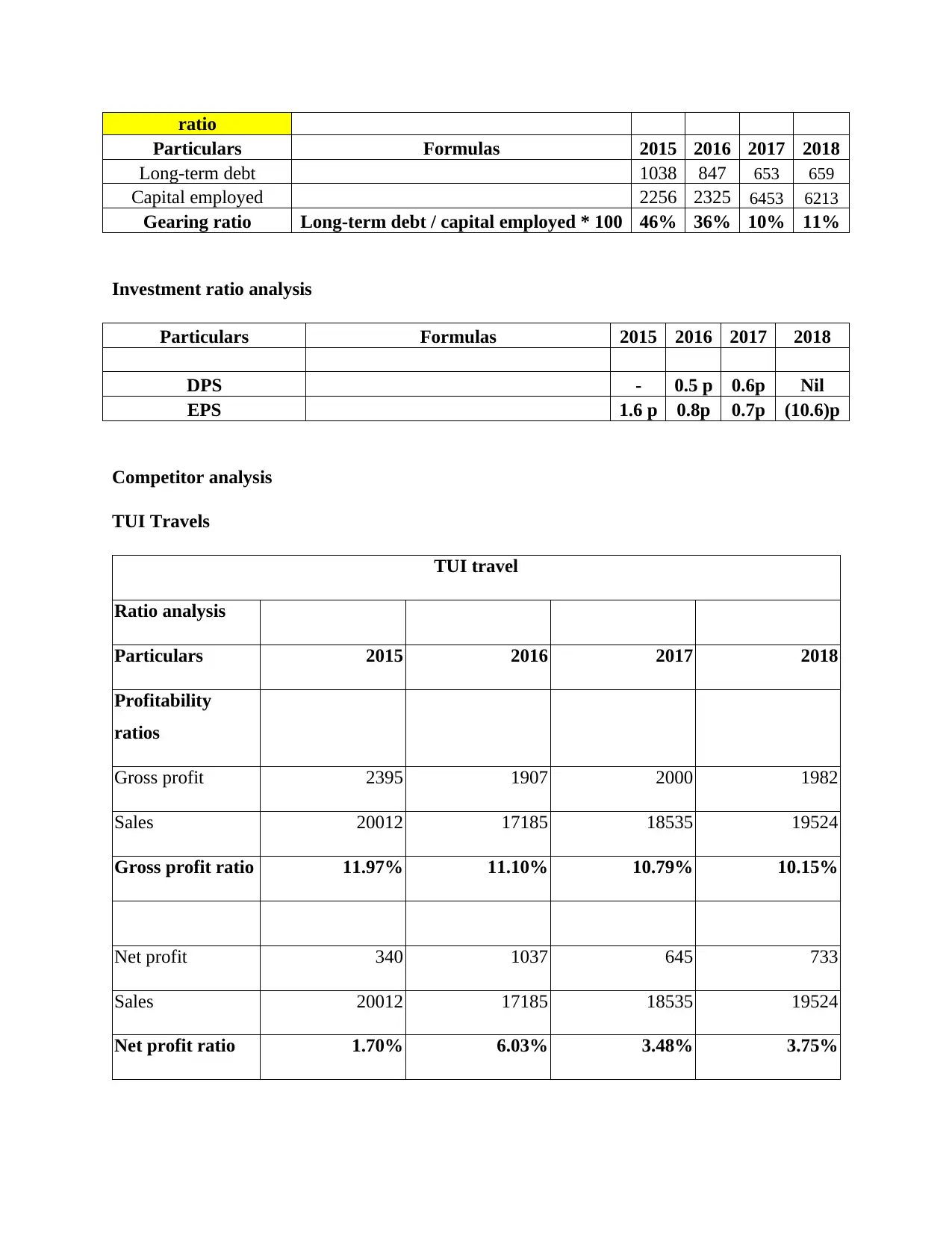
ratio
Particulars Formulas 2015 2016 2017 2018
Long-term debt 1038 847 653 659
Capital employed 2256 2325 6453 6213
Gearing ratio Long-term debt / capital employed * 100 46% 36% 10% 11%
Investment ratio analysis
Particulars Formulas 2015 2016 2017 2018
DPS - 0.5 p 0.6p Nil
EPS 1.6 p 0.8p 0.7p (10.6)p
Competitor analysis
TUI Travels
TUI travel
Ratio analysis
Particulars 2015 2016 2017 2018
Profitability
ratios
Gross profit 2395 1907 2000 1982
Sales 20012 17185 18535 19524
Gross profit ratio 11.97% 11.10% 10.79% 10.15%
Net profit 340 1037 645 733
Sales 20012 17185 18535 19524
Net profit ratio 1.70% 6.03% 3.48% 3.75%
Particulars Formulas 2015 2016 2017 2018
Long-term debt 1038 847 653 659
Capital employed 2256 2325 6453 6213
Gearing ratio Long-term debt / capital employed * 100 46% 36% 10% 11%
Investment ratio analysis
Particulars Formulas 2015 2016 2017 2018
DPS - 0.5 p 0.6p Nil
EPS 1.6 p 0.8p 0.7p (10.6)p
Competitor analysis
TUI Travels
TUI travel
Ratio analysis
Particulars 2015 2016 2017 2018
Profitability
ratios
Gross profit 2395 1907 2000 1982
Sales 20012 17185 18535 19524
Gross profit ratio 11.97% 11.10% 10.79% 10.15%
Net profit 340 1037 645 733
Sales 20012 17185 18535 19524
Net profit ratio 1.70% 6.03% 3.48% 3.75%
Paraphrase This Document
Need a fresh take? Get an instant paraphrase of this document with our AI Paraphraser
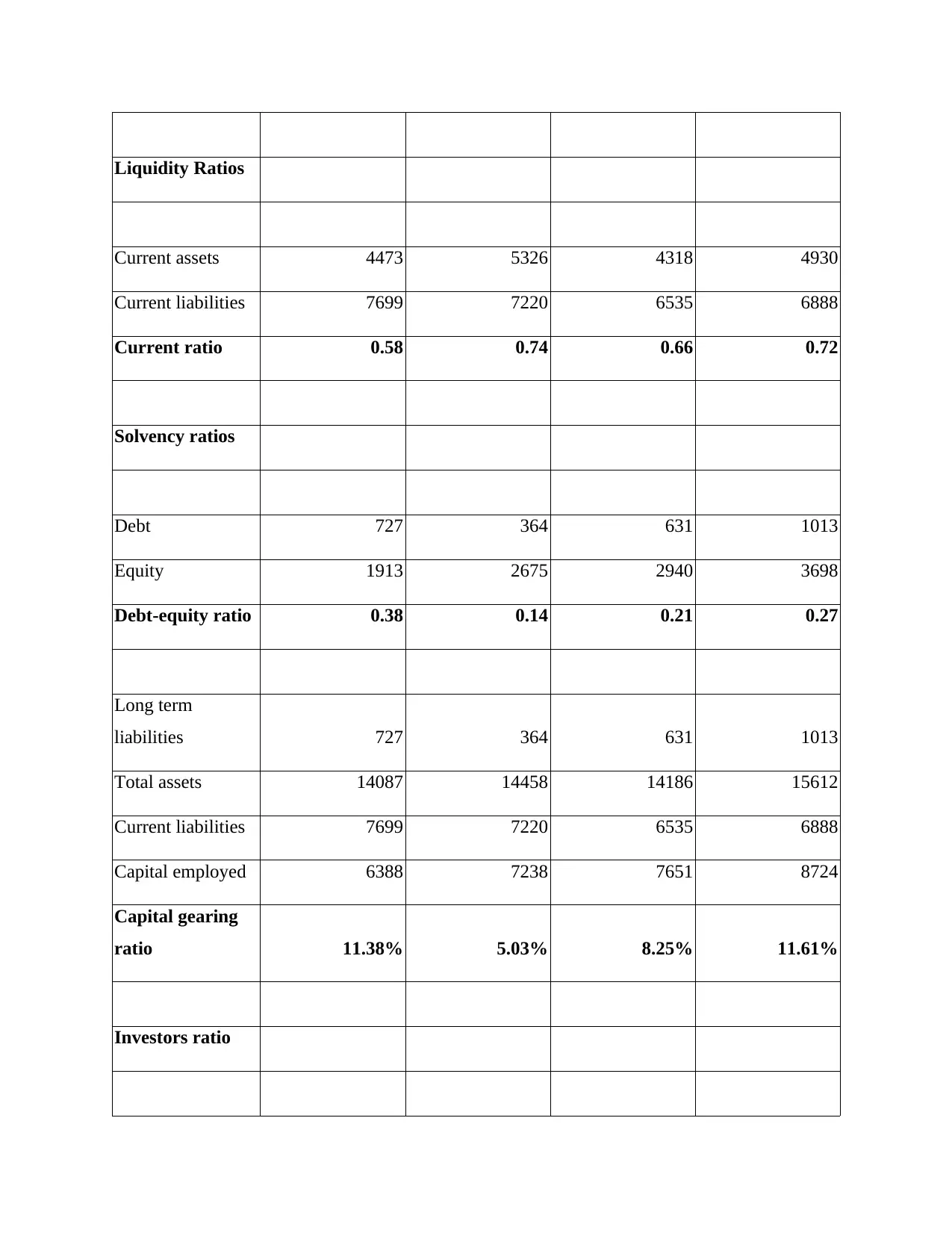
Liquidity Ratios
Current assets 4473 5326 4318 4930
Current liabilities 7699 7220 6535 6888
Current ratio 0.58 0.74 0.66 0.72
Solvency ratios
Debt 727 364 631 1013
Equity 1913 2675 2940 3698
Debt-equity ratio 0.38 0.14 0.21 0.27
Long term
liabilities 727 364 631 1013
Total assets 14087 14458 14186 15612
Current liabilities 7699 7220 6535 6888
Capital employed 6388 7238 7651 8724
Capital gearing
ratio 11.38% 5.03% 8.25% 11.61%
Investors ratio
Current assets 4473 5326 4318 4930
Current liabilities 7699 7220 6535 6888
Current ratio 0.58 0.74 0.66 0.72
Solvency ratios
Debt 727 364 631 1013
Equity 1913 2675 2940 3698
Debt-equity ratio 0.38 0.14 0.21 0.27
Long term
liabilities 727 364 631 1013
Total assets 14087 14458 14186 15612
Current liabilities 7699 7220 6535 6888
Capital employed 6388 7238 7651 8724
Capital gearing
ratio 11.38% 5.03% 8.25% 11.61%
Investors ratio
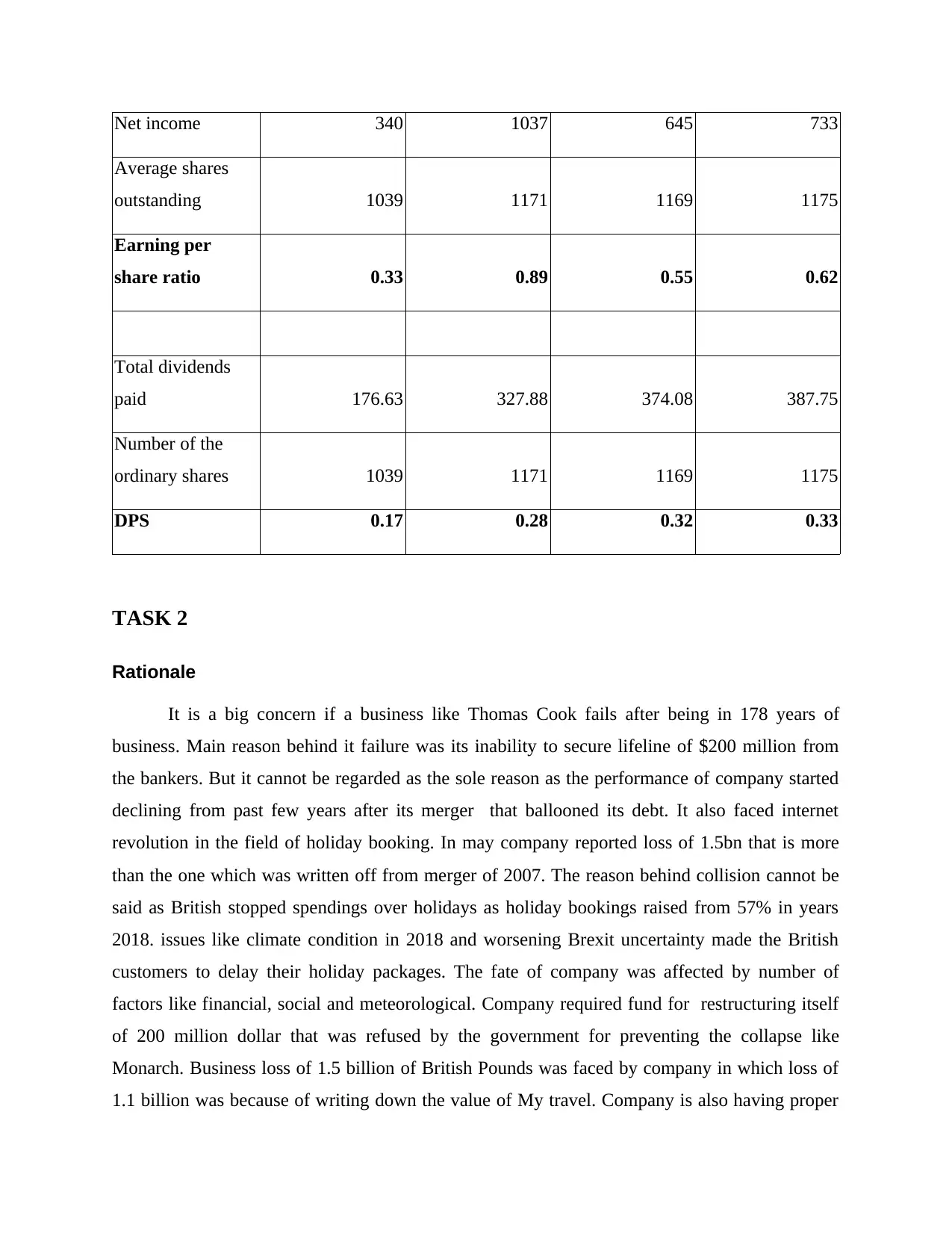
Net income 340 1037 645 733
Average shares
outstanding 1039 1171 1169 1175
Earning per
share ratio 0.33 0.89 0.55 0.62
Total dividends
paid 176.63 327.88 374.08 387.75
Number of the
ordinary shares 1039 1171 1169 1175
DPS 0.17 0.28 0.32 0.33
TASK 2
Rationale
It is a big concern if a business like Thomas Cook fails after being in 178 years of
business. Main reason behind it failure was its inability to secure lifeline of $200 million from
the bankers. But it cannot be regarded as the sole reason as the performance of company started
declining from past few years after its merger that ballooned its debt. It also faced internet
revolution in the field of holiday booking. In may company reported loss of 1.5bn that is more
than the one which was written off from merger of 2007. The reason behind collision cannot be
said as British stopped spendings over holidays as holiday bookings raised from 57% in years
2018. issues like climate condition in 2018 and worsening Brexit uncertainty made the British
customers to delay their holiday packages. The fate of company was affected by number of
factors like financial, social and meteorological. Company required fund for restructuring itself
of 200 million dollar that was refused by the government for preventing the collapse like
Monarch. Business loss of 1.5 billion of British Pounds was faced by company in which loss of
1.1 billion was because of writing down the value of My travel. Company is also having proper
Average shares
outstanding 1039 1171 1169 1175
Earning per
share ratio 0.33 0.89 0.55 0.62
Total dividends
paid 176.63 327.88 374.08 387.75
Number of the
ordinary shares 1039 1171 1169 1175
DPS 0.17 0.28 0.32 0.33
TASK 2
Rationale
It is a big concern if a business like Thomas Cook fails after being in 178 years of
business. Main reason behind it failure was its inability to secure lifeline of $200 million from
the bankers. But it cannot be regarded as the sole reason as the performance of company started
declining from past few years after its merger that ballooned its debt. It also faced internet
revolution in the field of holiday booking. In may company reported loss of 1.5bn that is more
than the one which was written off from merger of 2007. The reason behind collision cannot be
said as British stopped spendings over holidays as holiday bookings raised from 57% in years
2018. issues like climate condition in 2018 and worsening Brexit uncertainty made the British
customers to delay their holiday packages. The fate of company was affected by number of
factors like financial, social and meteorological. Company required fund for restructuring itself
of 200 million dollar that was refused by the government for preventing the collapse like
Monarch. Business loss of 1.5 billion of British Pounds was faced by company in which loss of
1.1 billion was because of writing down the value of My travel. Company is also having proper
⊘ This is a preview!⊘
Do you want full access?
Subscribe today to unlock all pages.

Trusted by 1+ million students worldwide
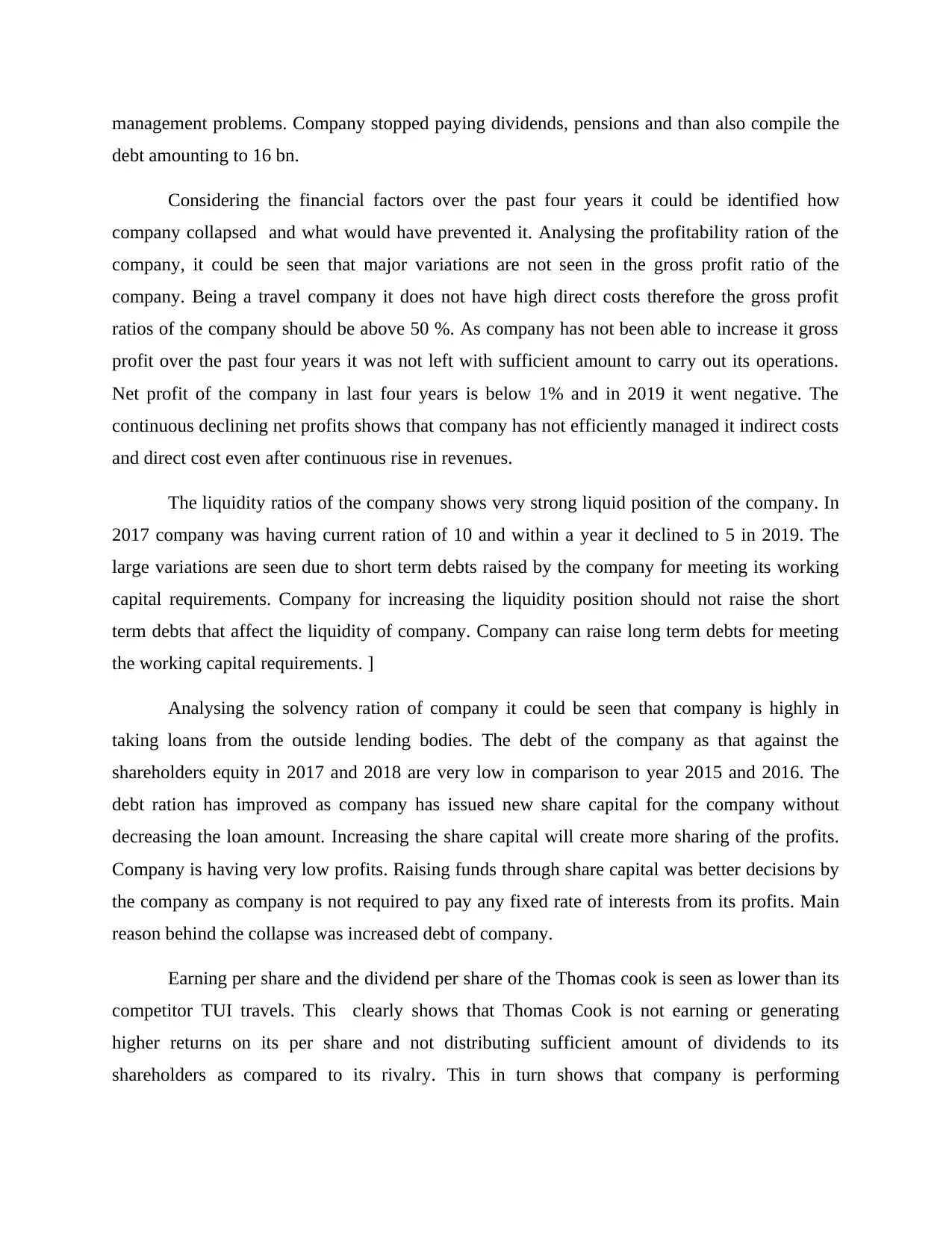
management problems. Company stopped paying dividends, pensions and than also compile the
debt amounting to 16 bn.
Considering the financial factors over the past four years it could be identified how
company collapsed and what would have prevented it. Analysing the profitability ration of the
company, it could be seen that major variations are not seen in the gross profit ratio of the
company. Being a travel company it does not have high direct costs therefore the gross profit
ratios of the company should be above 50 %. As company has not been able to increase it gross
profit over the past four years it was not left with sufficient amount to carry out its operations.
Net profit of the company in last four years is below 1% and in 2019 it went negative. The
continuous declining net profits shows that company has not efficiently managed it indirect costs
and direct cost even after continuous rise in revenues.
The liquidity ratios of the company shows very strong liquid position of the company. In
2017 company was having current ration of 10 and within a year it declined to 5 in 2019. The
large variations are seen due to short term debts raised by the company for meeting its working
capital requirements. Company for increasing the liquidity position should not raise the short
term debts that affect the liquidity of company. Company can raise long term debts for meeting
the working capital requirements. ]
Analysing the solvency ration of company it could be seen that company is highly in
taking loans from the outside lending bodies. The debt of the company as that against the
shareholders equity in 2017 and 2018 are very low in comparison to year 2015 and 2016. The
debt ration has improved as company has issued new share capital for the company without
decreasing the loan amount. Increasing the share capital will create more sharing of the profits.
Company is having very low profits. Raising funds through share capital was better decisions by
the company as company is not required to pay any fixed rate of interests from its profits. Main
reason behind the collapse was increased debt of company.
Earning per share and the dividend per share of the Thomas cook is seen as lower than its
competitor TUI travels. This clearly shows that Thomas Cook is not earning or generating
higher returns on its per share and not distributing sufficient amount of dividends to its
shareholders as compared to its rivalry. This in turn shows that company is performing
debt amounting to 16 bn.
Considering the financial factors over the past four years it could be identified how
company collapsed and what would have prevented it. Analysing the profitability ration of the
company, it could be seen that major variations are not seen in the gross profit ratio of the
company. Being a travel company it does not have high direct costs therefore the gross profit
ratios of the company should be above 50 %. As company has not been able to increase it gross
profit over the past four years it was not left with sufficient amount to carry out its operations.
Net profit of the company in last four years is below 1% and in 2019 it went negative. The
continuous declining net profits shows that company has not efficiently managed it indirect costs
and direct cost even after continuous rise in revenues.
The liquidity ratios of the company shows very strong liquid position of the company. In
2017 company was having current ration of 10 and within a year it declined to 5 in 2019. The
large variations are seen due to short term debts raised by the company for meeting its working
capital requirements. Company for increasing the liquidity position should not raise the short
term debts that affect the liquidity of company. Company can raise long term debts for meeting
the working capital requirements. ]
Analysing the solvency ration of company it could be seen that company is highly in
taking loans from the outside lending bodies. The debt of the company as that against the
shareholders equity in 2017 and 2018 are very low in comparison to year 2015 and 2016. The
debt ration has improved as company has issued new share capital for the company without
decreasing the loan amount. Increasing the share capital will create more sharing of the profits.
Company is having very low profits. Raising funds through share capital was better decisions by
the company as company is not required to pay any fixed rate of interests from its profits. Main
reason behind the collapse was increased debt of company.
Earning per share and the dividend per share of the Thomas cook is seen as lower than its
competitor TUI travels. This clearly shows that Thomas Cook is not earning or generating
higher returns on its per share and not distributing sufficient amount of dividends to its
shareholders as compared to its rivalry. This in turn shows that company is performing
Paraphrase This Document
Need a fresh take? Get an instant paraphrase of this document with our AI Paraphraser
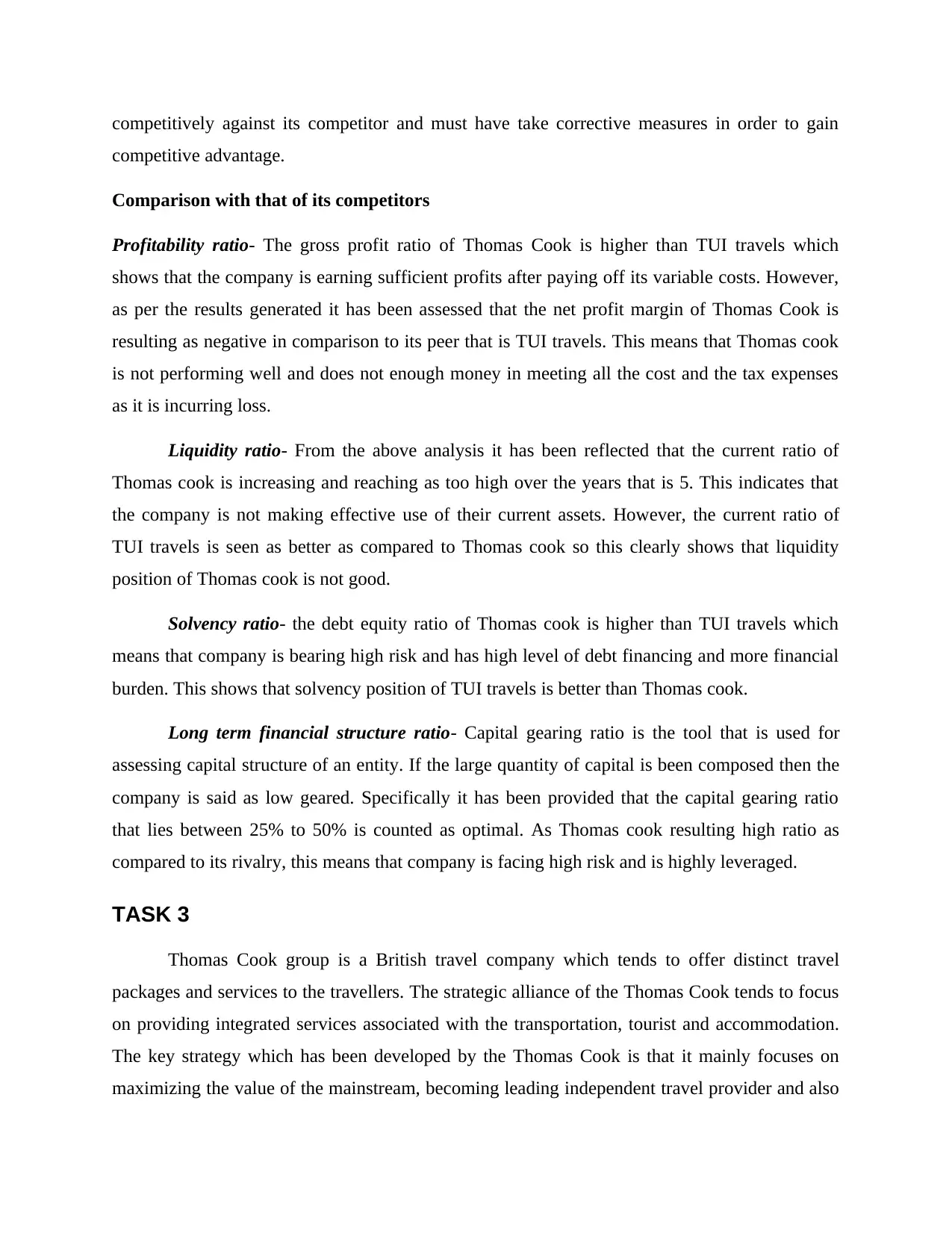
competitively against its competitor and must have take corrective measures in order to gain
competitive advantage.
Comparison with that of its competitors
Profitability ratio- The gross profit ratio of Thomas Cook is higher than TUI travels which
shows that the company is earning sufficient profits after paying off its variable costs. However,
as per the results generated it has been assessed that the net profit margin of Thomas Cook is
resulting as negative in comparison to its peer that is TUI travels. This means that Thomas cook
is not performing well and does not enough money in meeting all the cost and the tax expenses
as it is incurring loss.
Liquidity ratio- From the above analysis it has been reflected that the current ratio of
Thomas cook is increasing and reaching as too high over the years that is 5. This indicates that
the company is not making effective use of their current assets. However, the current ratio of
TUI travels is seen as better as compared to Thomas cook so this clearly shows that liquidity
position of Thomas cook is not good.
Solvency ratio- the debt equity ratio of Thomas cook is higher than TUI travels which
means that company is bearing high risk and has high level of debt financing and more financial
burden. This shows that solvency position of TUI travels is better than Thomas cook.
Long term financial structure ratio- Capital gearing ratio is the tool that is used for
assessing capital structure of an entity. If the large quantity of capital is been composed then the
company is said as low geared. Specifically it has been provided that the capital gearing ratio
that lies between 25% to 50% is counted as optimal. As Thomas cook resulting high ratio as
compared to its rivalry, this means that company is facing high risk and is highly leveraged.
TASK 3
Thomas Cook group is a British travel company which tends to offer distinct travel
packages and services to the travellers. The strategic alliance of the Thomas Cook tends to focus
on providing integrated services associated with the transportation, tourist and accommodation.
The key strategy which has been developed by the Thomas Cook is that it mainly focuses on
maximizing the value of the mainstream, becoming leading independent travel provider and also
competitive advantage.
Comparison with that of its competitors
Profitability ratio- The gross profit ratio of Thomas Cook is higher than TUI travels which
shows that the company is earning sufficient profits after paying off its variable costs. However,
as per the results generated it has been assessed that the net profit margin of Thomas Cook is
resulting as negative in comparison to its peer that is TUI travels. This means that Thomas cook
is not performing well and does not enough money in meeting all the cost and the tax expenses
as it is incurring loss.
Liquidity ratio- From the above analysis it has been reflected that the current ratio of
Thomas cook is increasing and reaching as too high over the years that is 5. This indicates that
the company is not making effective use of their current assets. However, the current ratio of
TUI travels is seen as better as compared to Thomas cook so this clearly shows that liquidity
position of Thomas cook is not good.
Solvency ratio- the debt equity ratio of Thomas cook is higher than TUI travels which
means that company is bearing high risk and has high level of debt financing and more financial
burden. This shows that solvency position of TUI travels is better than Thomas cook.
Long term financial structure ratio- Capital gearing ratio is the tool that is used for
assessing capital structure of an entity. If the large quantity of capital is been composed then the
company is said as low geared. Specifically it has been provided that the capital gearing ratio
that lies between 25% to 50% is counted as optimal. As Thomas cook resulting high ratio as
compared to its rivalry, this means that company is facing high risk and is highly leveraged.
TASK 3
Thomas Cook group is a British travel company which tends to offer distinct travel
packages and services to the travellers. The strategic alliance of the Thomas Cook tends to focus
on providing integrated services associated with the transportation, tourist and accommodation.
The key strategy which has been developed by the Thomas Cook is that it mainly focuses on
maximizing the value of the mainstream, becoming leading independent travel provider and also
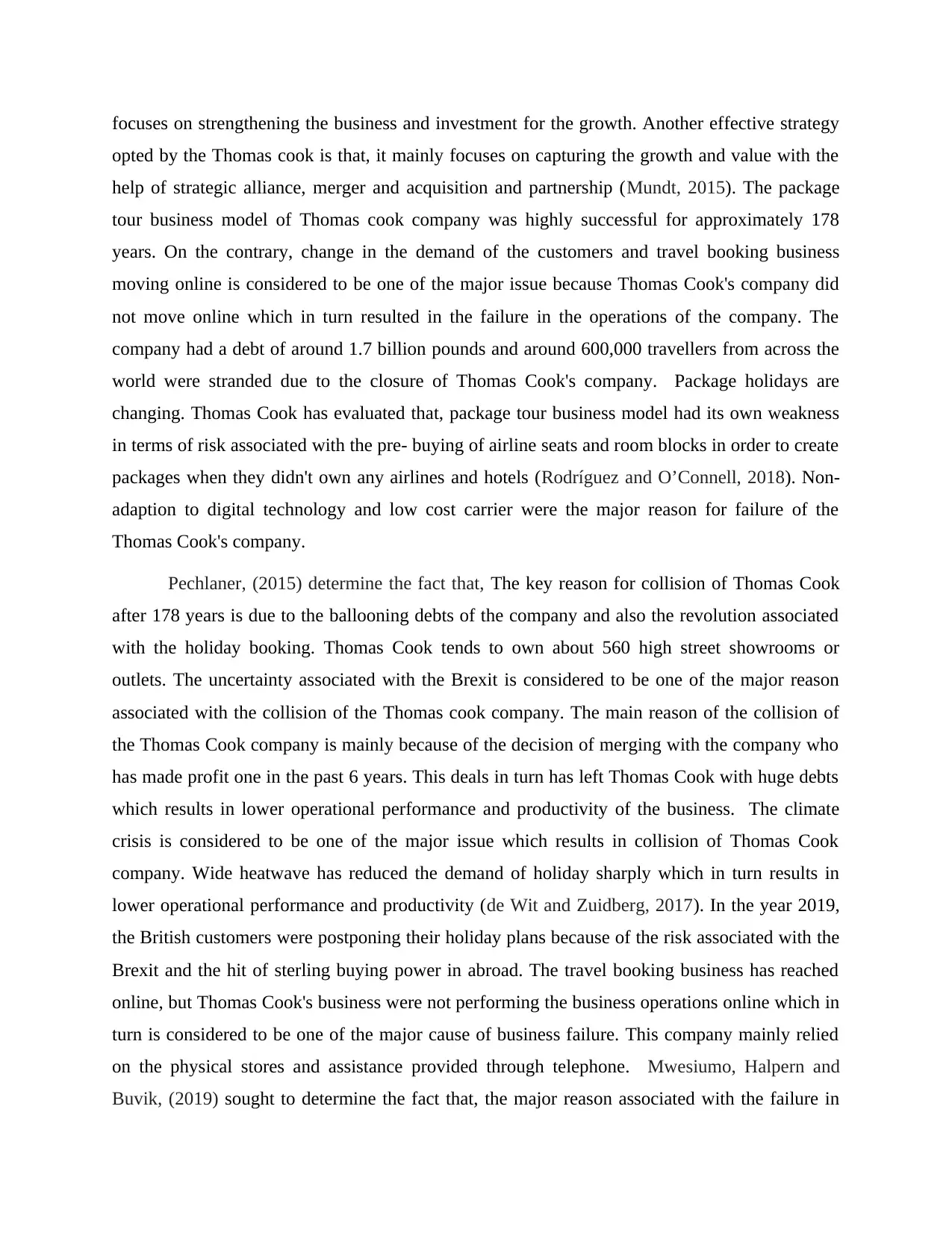
focuses on strengthening the business and investment for the growth. Another effective strategy
opted by the Thomas cook is that, it mainly focuses on capturing the growth and value with the
help of strategic alliance, merger and acquisition and partnership (Mundt, 2015). The package
tour business model of Thomas cook company was highly successful for approximately 178
years. On the contrary, change in the demand of the customers and travel booking business
moving online is considered to be one of the major issue because Thomas Cook's company did
not move online which in turn resulted in the failure in the operations of the company. The
company had a debt of around 1.7 billion pounds and around 600,000 travellers from across the
world were stranded due to the closure of Thomas Cook's company. Package holidays are
changing. Thomas Cook has evaluated that, package tour business model had its own weakness
in terms of risk associated with the pre- buying of airline seats and room blocks in order to create
packages when they didn't own any airlines and hotels (Rodríguez and O’Connell, 2018). Non-
adaption to digital technology and low cost carrier were the major reason for failure of the
Thomas Cook's company.
Pechlaner, (2015) determine the fact that, The key reason for collision of Thomas Cook
after 178 years is due to the ballooning debts of the company and also the revolution associated
with the holiday booking. Thomas Cook tends to own about 560 high street showrooms or
outlets. The uncertainty associated with the Brexit is considered to be one of the major reason
associated with the collision of the Thomas cook company. The main reason of the collision of
the Thomas Cook company is mainly because of the decision of merging with the company who
has made profit one in the past 6 years. This deals in turn has left Thomas Cook with huge debts
which results in lower operational performance and productivity of the business. The climate
crisis is considered to be one of the major issue which results in collision of Thomas Cook
company. Wide heatwave has reduced the demand of holiday sharply which in turn results in
lower operational performance and productivity (de Wit and Zuidberg, 2017). In the year 2019,
the British customers were postponing their holiday plans because of the risk associated with the
Brexit and the hit of sterling buying power in abroad. The travel booking business has reached
online, but Thomas Cook's business were not performing the business operations online which in
turn is considered to be one of the major cause of business failure. This company mainly relied
on the physical stores and assistance provided through telephone. Mwesiumo, Halpern and
Buvik, (2019) sought to determine the fact that, the major reason associated with the failure in
opted by the Thomas cook is that, it mainly focuses on capturing the growth and value with the
help of strategic alliance, merger and acquisition and partnership (Mundt, 2015). The package
tour business model of Thomas cook company was highly successful for approximately 178
years. On the contrary, change in the demand of the customers and travel booking business
moving online is considered to be one of the major issue because Thomas Cook's company did
not move online which in turn resulted in the failure in the operations of the company. The
company had a debt of around 1.7 billion pounds and around 600,000 travellers from across the
world were stranded due to the closure of Thomas Cook's company. Package holidays are
changing. Thomas Cook has evaluated that, package tour business model had its own weakness
in terms of risk associated with the pre- buying of airline seats and room blocks in order to create
packages when they didn't own any airlines and hotels (Rodríguez and O’Connell, 2018). Non-
adaption to digital technology and low cost carrier were the major reason for failure of the
Thomas Cook's company.
Pechlaner, (2015) determine the fact that, The key reason for collision of Thomas Cook
after 178 years is due to the ballooning debts of the company and also the revolution associated
with the holiday booking. Thomas Cook tends to own about 560 high street showrooms or
outlets. The uncertainty associated with the Brexit is considered to be one of the major reason
associated with the collision of the Thomas cook company. The main reason of the collision of
the Thomas Cook company is mainly because of the decision of merging with the company who
has made profit one in the past 6 years. This deals in turn has left Thomas Cook with huge debts
which results in lower operational performance and productivity of the business. The climate
crisis is considered to be one of the major issue which results in collision of Thomas Cook
company. Wide heatwave has reduced the demand of holiday sharply which in turn results in
lower operational performance and productivity (de Wit and Zuidberg, 2017). In the year 2019,
the British customers were postponing their holiday plans because of the risk associated with the
Brexit and the hit of sterling buying power in abroad. The travel booking business has reached
online, but Thomas Cook's business were not performing the business operations online which in
turn is considered to be one of the major cause of business failure. This company mainly relied
on the physical stores and assistance provided through telephone. Mwesiumo, Halpern and
Buvik, (2019) sought to determine the fact that, the major reason associated with the failure in
⊘ This is a preview!⊘
Do you want full access?
Subscribe today to unlock all pages.

Trusted by 1+ million students worldwide
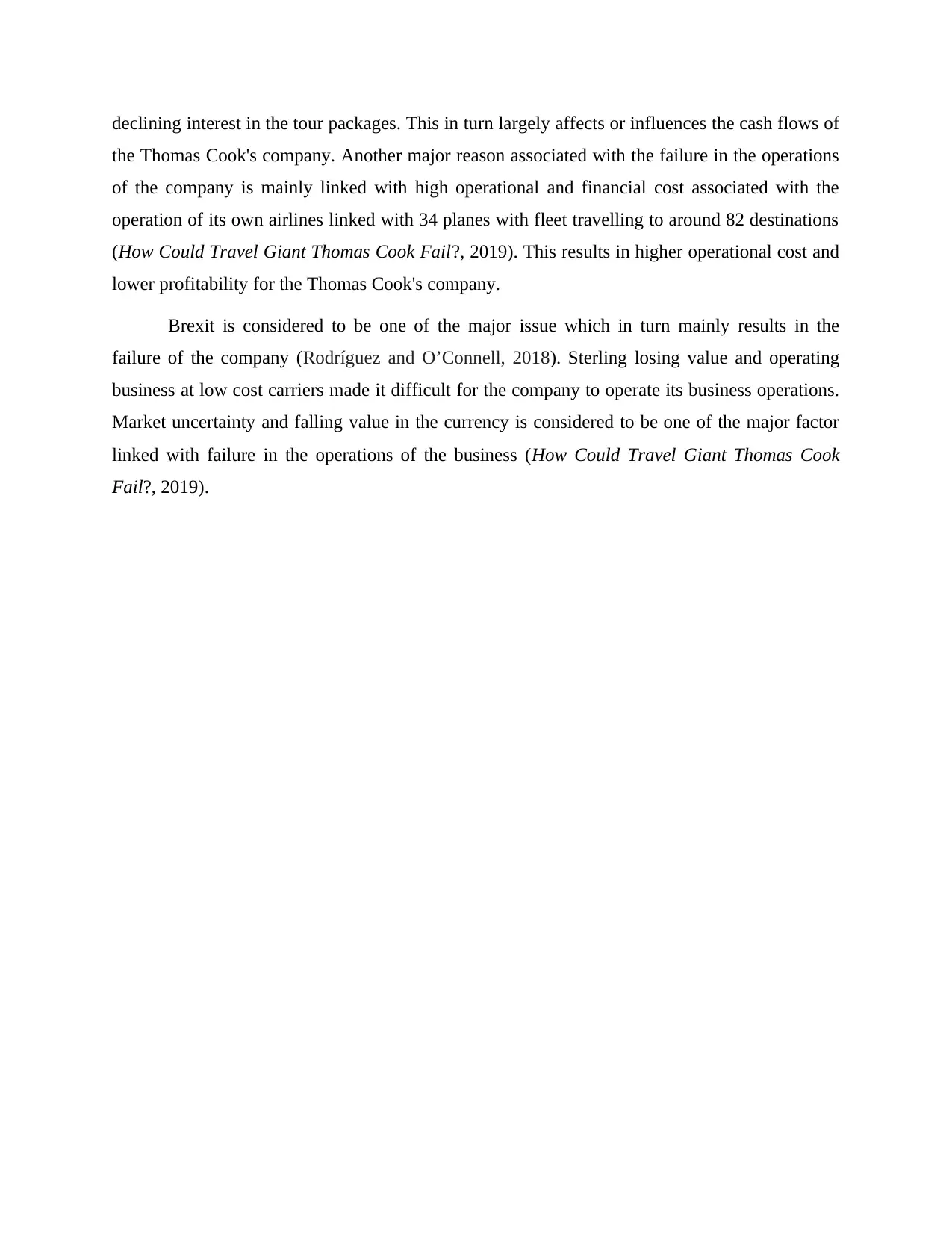
declining interest in the tour packages. This in turn largely affects or influences the cash flows of
the Thomas Cook's company. Another major reason associated with the failure in the operations
of the company is mainly linked with high operational and financial cost associated with the
operation of its own airlines linked with 34 planes with fleet travelling to around 82 destinations
(How Could Travel Giant Thomas Cook Fail?, 2019). This results in higher operational cost and
lower profitability for the Thomas Cook's company.
Brexit is considered to be one of the major issue which in turn mainly results in the
failure of the company (Rodríguez and O’Connell, 2018). Sterling losing value and operating
business at low cost carriers made it difficult for the company to operate its business operations.
Market uncertainty and falling value in the currency is considered to be one of the major factor
linked with failure in the operations of the business (How Could Travel Giant Thomas Cook
Fail?, 2019).
the Thomas Cook's company. Another major reason associated with the failure in the operations
of the company is mainly linked with high operational and financial cost associated with the
operation of its own airlines linked with 34 planes with fleet travelling to around 82 destinations
(How Could Travel Giant Thomas Cook Fail?, 2019). This results in higher operational cost and
lower profitability for the Thomas Cook's company.
Brexit is considered to be one of the major issue which in turn mainly results in the
failure of the company (Rodríguez and O’Connell, 2018). Sterling losing value and operating
business at low cost carriers made it difficult for the company to operate its business operations.
Market uncertainty and falling value in the currency is considered to be one of the major factor
linked with failure in the operations of the business (How Could Travel Giant Thomas Cook
Fail?, 2019).
Paraphrase This Document
Need a fresh take? Get an instant paraphrase of this document with our AI Paraphraser
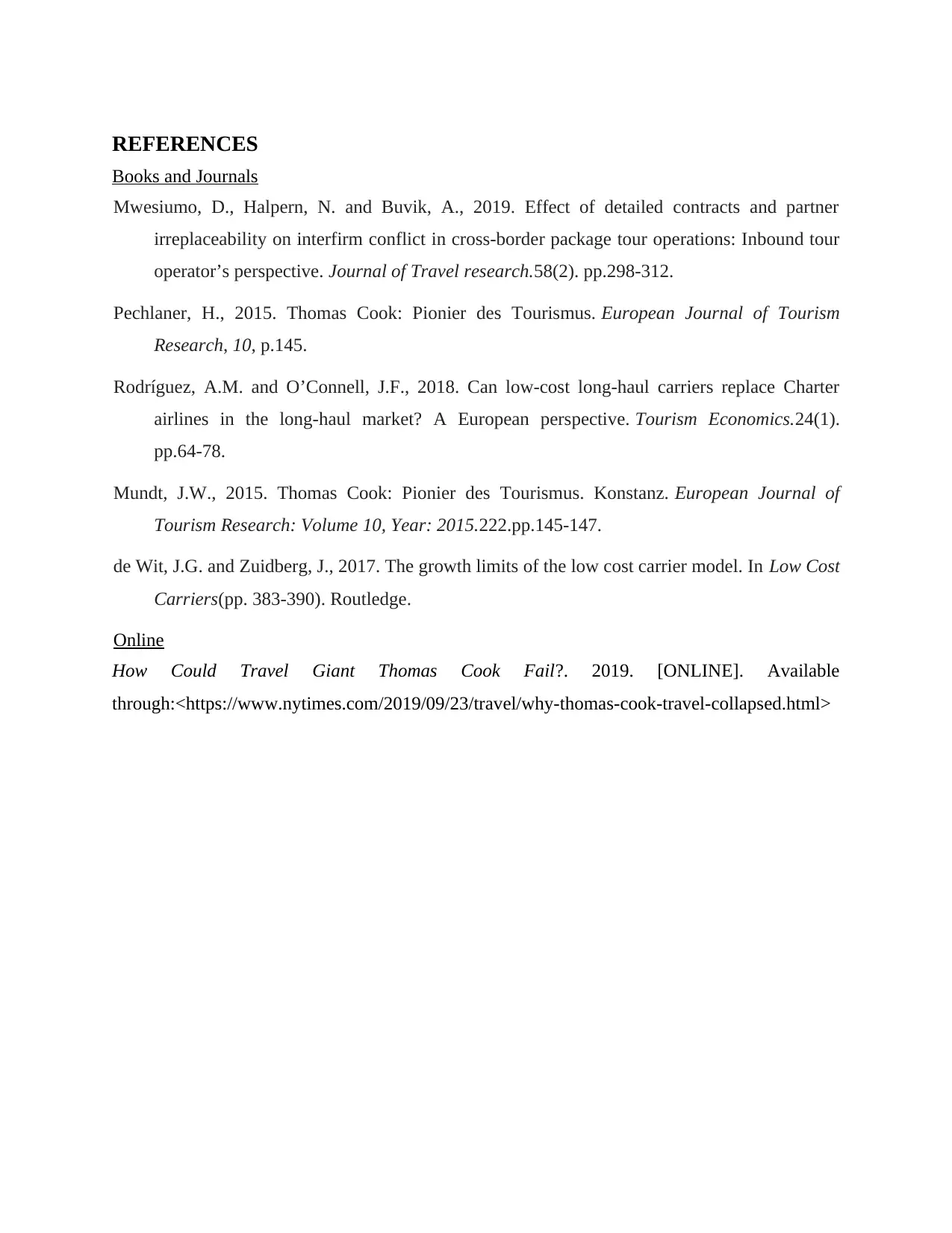
REFERENCES
Books and Journals
Mwesiumo, D., Halpern, N. and Buvik, A., 2019. Effect of detailed contracts and partner
irreplaceability on interfirm conflict in cross-border package tour operations: Inbound tour
operator’s perspective. Journal of Travel research.58(2). pp.298-312.
Pechlaner, H., 2015. Thomas Cook: Pionier des Tourismus. European Journal of Tourism
Research, 10, p.145.
Rodríguez, A.M. and O’Connell, J.F., 2018. Can low-cost long-haul carriers replace Charter
airlines in the long-haul market? A European perspective. Tourism Economics.24(1).
pp.64-78.
Mundt, J.W., 2015. Thomas Cook: Pionier des Tourismus. Konstanz. European Journal of
Tourism Research: Volume 10, Year: 2015.222.pp.145-147.
de Wit, J.G. and Zuidberg, J., 2017. The growth limits of the low cost carrier model. In Low Cost
Carriers(pp. 383-390). Routledge.
Online
How Could Travel Giant Thomas Cook Fail?. 2019. [ONLINE]. Available
through:<https://www.nytimes.com/2019/09/23/travel/why-thomas-cook-travel-collapsed.html>
Books and Journals
Mwesiumo, D., Halpern, N. and Buvik, A., 2019. Effect of detailed contracts and partner
irreplaceability on interfirm conflict in cross-border package tour operations: Inbound tour
operator’s perspective. Journal of Travel research.58(2). pp.298-312.
Pechlaner, H., 2015. Thomas Cook: Pionier des Tourismus. European Journal of Tourism
Research, 10, p.145.
Rodríguez, A.M. and O’Connell, J.F., 2018. Can low-cost long-haul carriers replace Charter
airlines in the long-haul market? A European perspective. Tourism Economics.24(1).
pp.64-78.
Mundt, J.W., 2015. Thomas Cook: Pionier des Tourismus. Konstanz. European Journal of
Tourism Research: Volume 10, Year: 2015.222.pp.145-147.
de Wit, J.G. and Zuidberg, J., 2017. The growth limits of the low cost carrier model. In Low Cost
Carriers(pp. 383-390). Routledge.
Online
How Could Travel Giant Thomas Cook Fail?. 2019. [ONLINE]. Available
through:<https://www.nytimes.com/2019/09/23/travel/why-thomas-cook-travel-collapsed.html>
1 out of 11
Your All-in-One AI-Powered Toolkit for Academic Success.
+13062052269
info@desklib.com
Available 24*7 on WhatsApp / Email
![[object Object]](/_next/static/media/star-bottom.7253800d.svg)
Unlock your academic potential
© 2024 | Zucol Services PVT LTD | All rights reserved.